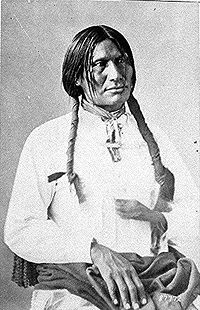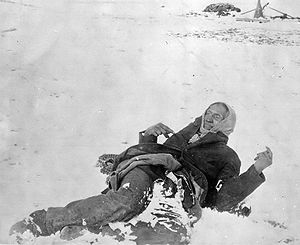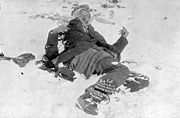
Spotted Elk
Encyclopedia

Tribal chief
A tribal chief is the leader of a tribal society or chiefdom. Tribal societies with social stratification under a single leader emerged in the Neolithic period out of earlier tribal structures with little stratification, and they remained prevalent throughout the Iron Age.In the case of ...
of the Miniconjou
Miniconjou
The Miniconjou are a Native American people constituting a subdivision of the Lakota Sioux, who formerly inhabited an area from the Black Hills in South Dakota to the Platte River. The contemporary population lives mostly in west-central South Dakota...
Lakota Sioux. He was a son of chief One Horn (Miniconjou) and became a chief upon the death of his father. He was a highly renowned chief with skills in war and negotiations. He became known as Big Foot or Sitȟáŋka not to be confused with the Oglala Bigfoot who was known Ste Si Tanka or Chetan keah. In 1890 he was killed in South Dakota
South Dakota
South Dakota is a state located in the Midwestern region of the United States. It is named after the Lakota and Dakota Sioux American Indian tribes. Once a part of Dakota Territory, South Dakota became a state on November 2, 1889. The state has an area of and an estimated population of just over...
, along with at least 150 other members of his tribe, by the United States Army
United States Army
The United States Army is the main branch of the United States Armed Forces responsible for land-based military operations. It is the largest and oldest established branch of the U.S. military, and is one of seven U.S. uniformed services...
in what came to be known as the Wounded Knee Massacre
Wounded Knee Massacre
The Wounded Knee Massacre happened on December 29, 1890, near Wounded Knee Creek on the Lakota Pine Ridge Indian Reservation in South Dakota, USA. On the day before, a detachment of the U.S. 7th Cavalry Regiment commanded by Major Samuel M...
.
Early life
Spotted Elk (Unpan Glešká {Lakota} sometimes spelled oh-pong-ge-le-skah ) was born the son of Lakota Sioux chief One Horn about 1826. His family belonged to the Mniconjou ("Planters by the River") subgroup of the Teton Lakota (Sioux). He had three brothers: Roman NoseRoman Nose
Roman Nose, a.k.a. Hook Nose , was a Native American of the Northern Cheyenne, and possibly the greatest and most influential warrior during the Plains Indian War of the 1860s...
, Frog and Touch the Clouds
Touch the Clouds
Touch the Clouds was a chief of the Minneconjou Teton Lakota known for his bravery and skill in battle, physical strength and for his diplomacy in counsel. The youngest son of Lone Horn, he was brother to Spotted Elk, Frog, and Roman Nose...
, each of whom were to become leaders of Mniconjou bands. Spotted Elk became the chief of his tribe at his father's death at age 85 in 1875.
Skillful diplomat
As chief, Spotted Elk (who later became known by the name of "Big Foot" or Sitȟáŋka) was considered a great man of peace. He was best known among his people for his political and diplomaticDiplomacy
Diplomacy is the art and practice of conducting negotiations between representatives of groups or states...
successes. He was skilled at settling quarrels between rival parties, and was often in great demand among other Teton bands.
Alliance with Sitting Bull and Crazy Horse
During the 1870s, he allied his tribe with Sitting BullSitting Bull
Sitting Bull Sitting Bull Sitting Bull (Lakota: Tȟatȟáŋka Íyotake (in Standard Lakota Orthography), also nicknamed Slon-he or "Slow"; (c. 1831 – December 15, 1890) was a Hunkpapa Lakota Sioux holy man who led his people as a tribal chief during years of resistance to United States government policies...
and his cousin, Crazy Horse
Crazy Horse
Crazy Horse was a Native American war leader of the Oglala Lakota. He took up arms against the U.S...
(together with Touch the Clouds) against the U.S. Army. He saw no major action during the war in 1876-77. The Miniconjou Lakota suffered during the Great Sioux War of 1876-77
Great Sioux War of 1876-77
The Great Sioux War of 1876, also known as the Black Hills War, was a series of battles and negotiations which occurred between 1876 and 1877 involving the Lakota and Northern Cheyenne, against the United States...
, after which they surrendered.
Reservation placement
Following the Sioux WarsSioux Wars
The Sioux Wars were a series of conflicts between the United States and various subgroups of the Sioux people that occurred in the latter half of the 19th century...
, the government placed the Minneconjou on the Cheyenne River Indian Reservation
Cheyenne River Indian Reservation
The Cheyenne River Indian Reservation was created by the United States in 1889 by breaking up the Great Sioux Reservation, following its victory over the Lakota in a series of wars in the 1870s. The reservation covers almost all of Dewey and Ziebach counties in South Dakota...
in South Dakota. Spotted Elk encouraged his people to adapt to life on the reservation by developing sustainable agriculture
Agriculture
Agriculture is the cultivation of animals, plants, fungi and other life forms for food, fiber, and other products used to sustain life. Agriculture was the key implement in the rise of sedentary human civilization, whereby farming of domesticated species created food surpluses that nurtured the...
and building school
School
A school is an institution designed for the teaching of students under the direction of teachers. Most countries have systems of formal education, which is commonly compulsory. In these systems, students progress through a series of schools...
s for Lakota children. Spotted Elk was among the first American Indian
Indigenous peoples of the Americas
The indigenous peoples of the Americas are the pre-Columbian inhabitants of North and South America, their descendants and other ethnic groups who are identified with those peoples. Indigenous peoples are known in Canada as Aboriginal peoples, and in the United States as Native Americans...
s to raise corn
Maize
Maize known in many English-speaking countries as corn or mielie/mealie, is a grain domesticated by indigenous peoples in Mesoamerica in prehistoric times. The leafy stalk produces ears which contain seeds called kernels. Though technically a grain, maize kernels are used in cooking as a vegetable...
in accordance with government standards. Spotted Elk also advocated that his people take a peaceful attitude toward white settlers.
New religious movement
Due to poor living conditions on the reservations, the Lakota struggled greatly to survive. In some cases corrupt Indian agents carried out fraud and stole from supplies and annuities from the Lakota. By 1889 they were in despair and looked for change from their problems.The radical solution came in the form of the "Ghost Dance
Ghost Dance
The Ghost Dance was a new religious movement which was incorporated into numerous Native American belief systems. The traditional ritual used in the Ghost Dance, the circle dance, has been used by many Native Americans since prehistoric times...
" movement, a new religion initiated by Paiute
Paiute
Paiute refers to three closely related groups of Native Americans — the Northern Paiute of California, Idaho, Nevada and Oregon; the Owens Valley Paiute of California and Nevada; and the Southern Paiute of Arizona, southeastern California and Nevada, and Utah.-Origin of name:The origin of...
prophet
Prophet
In religion, a prophet, from the Greek word προφήτης profitis meaning "foreteller", is an individual who is claimed to have been contacted by the supernatural or the divine, and serves as an intermediary with humanity, delivering this newfound knowledge from the supernatural entity to other people...
Wovoka
Wovoka
Wovoka , also known as Jack Wilson, was the Northern Paiute religious leader who founded the Ghost Dance movement. Wovoka means "cutter" or "wood cutter" in the Northern Paiute language.-Biography:...
. Spotted Elk and the Lakota became among the most enthusiastic believers in the Ghost Dance ceremony when it arrived among them in the spring of 1890. Although government-imposed reservation rules outlawed the practice of the religion, the movement swept like a wildfire through the camps. Local Indian agents reacted with alarm. Some agents successfully suppressed the dancers; others called for federal troops to restore order.
The invitation of Chief Red Cloud
After Sitting Bull was killed on the Standing Rock Reservation in 1890, his followers fled for refuge at the camp of his half-brother Chief Spotted Elk. In December 1890, fearing arrest and government reprisals against his band, Spotted Elk headed south to the Pine Ridge Reservation at the invitation of Chief Red Cloud. Red Cloud hoped that his fellow chief could help make peace. Hoping to find safety there, flying a white flag and with no intention of fighting, Spotted Elk contracted pneumoniaPneumonia
Pneumonia is an inflammatory condition of the lung—especially affecting the microscopic air sacs —associated with fever, chest symptoms, and a lack of air space on a chest X-ray. Pneumonia is typically caused by an infection but there are a number of other causes...
on the journey to Pine Ridge.
Controversial photograph
The photograph attached to this page is a mis-identification of the Miniconjou Chief Spotted Elk. This is actually a photograph of an Oglala Bigfoot who was born in 1832 and who died after Wounded Knee sometime in 1899. There has been a lot of confusion surrounding this photograph but there is scattered documentation concerning this. Recently the Beinecke Library at Yale University released a copy of the original portfolio which includes the above photograph, another profile photo, and two photographs of this man's wife. They are labeled Bigfoot and White Hawk, and this is a portfolio of Oglalas and not Miniconjou. This Bigfoot's name was Ste Si tanka, which translates to lame Si Tanka, indicating there was something wrong with his foot or leg. He might have had a limp. The name that was given to Chief Spotted Elk at Ft. Bennett by the wasicu, was simply Si Tanka (or Bigfoot). The Oglala Bigfoot was married to a woman named White Horse Owner. It isn't clear if White Hawk was another translation error or if she was an earlier wife but He Dog states in an interview that This Ste Si Tanka was the father of Plenty Bear and Six Feathers. Census Documents from 1893-1899 confirm this. Also elsewhere, John Colhoff, interpreter, states that this was the Oglala Bigfoot. For further information contact Calvin Spotted Elk, the great great grandson of Chief Spotted Elk. He has photographs of his grandfather that should replace the one linked here.Peaceful surrender
On December 29, the 7th Cavalry intercepted the Lakota. Ill with pneumonia, Spotted Elk surrendered peacefully. The cavalry took him and his band into custody and escorted them to a site near Wounded Knee Creek, where they were to set up camp. The campsite was already established with a store and several log houses.Massacre at Wounded Knee


Wounded Knee Massacre
The Wounded Knee Massacre happened on December 29, 1890, near Wounded Knee Creek on the Lakota Pine Ridge Indian Reservation in South Dakota, USA. On the day before, a detachment of the U.S. 7th Cavalry Regiment commanded by Major Samuel M...
', Colonel
Colonel
Colonel , abbreviated Col or COL, is a military rank of a senior commissioned officer. It or a corresponding rank exists in most armies and in many air forces; the naval equivalent rank is generally "Captain". It is also used in some police forces and other paramilitary rank structures...
James Forsyth arrived at Wounded Knee Creek
Wounded Knee Creek
Wounded Knee Creek is a tributary of the White River, approximately long, in southwestern South Dakota in the United States. Its Lakota name is '....
. He ordered his men to place four Hotchkiss cannons
Hotchkiss gun
The Hotchkiss gun can refer to different products of the Hotchkiss arms company starting in the late 19th century. It usually refers to the 1.65-inch light mountain gun; there was also a 3-inch Hotchkiss gun...
in position around the area in which the Indians had been forced to camp. On the morning of December 29 soldiers under the command of Colonel Forsyth entered the camp and demanded that the Lakota give up their weaponry. In the confrontation that ensued, a firearm
Firearm
A firearm is a weapon that launches one, or many, projectile at high velocity through confined burning of a propellant. This subsonic burning process is technically known as deflagration, as opposed to supersonic combustion known as a detonation. In older firearms, the propellant was typically...
was discharged. It was later believed to have been by a deaf man named Black Coyote
Black Coyote
Black Coyote was a Lakota Sioux who refused to give up his weapon at the battle of Wounded Knee and is believed to have unintentionally triggered the terrible massacre....
, who presumably did not hear the order to put down his rifle. A large gun fight quickly ensued. The US forces killed at least 150 Lakota men, women and children, and Spotted Elk was among those massacred.
External links
- U-s-history.com, Lakota Chief Big Foot
- Indigenouspeople.net, Lakota Chief Big Foot
- Lastoftheindependents.com, Lakota Chief Big Foot and the Ghost Dance

